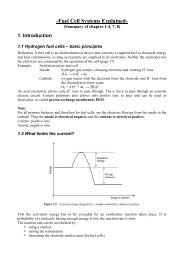Chapter 8. ORGANIC SOLAR CELLS - from and for SET students
Chapter 8. ORGANIC SOLAR CELLS - from and for SET students
Chapter 8. ORGANIC SOLAR CELLS - from and for SET students
Create successful ePaper yourself
Turn your PDF publications into a flip-book with our unique Google optimized e-Paper software.
<strong>Chapter</strong> 2<br />
c-Si Technology<br />
2.1 Continuity Equation<br />
In the first section the generation-recombination mechanism will be outlined followed by the the surface recombination.<br />
2.1.1 Generation-Recombination<br />
In thermal equilibrium the thermal generation is equal to thermal recombination. Also in static equilibrium the<br />
excess generation is equal to excess recombination. One can study recombination by investigating the effect by<br />
simply switching off a disturbance. By doing so the relaxation time (life time) of the system to return to its<br />
initial state can be measured. When working out some equation <strong>for</strong> that then we get that the carrier density is<br />
given by:<br />
in which τn,0 is the lifetime of the minority carrier, which is given by:<br />
δn(t) = δn(0)e −t<br />
τ n,0 (2.1)<br />
τn,0 = 1<br />
Other recombination mechanism are the Shockley-Read-Hall recombination in which we have states in the<br />
b<strong>and</strong>-gap that can facilitate recombination. In that case the life time is given by:<br />
τpt =<br />
αrp0<br />
1<br />
vthσpNt<br />
in which σp is the capture cross section <strong>for</strong> holes <strong>and</strong> Nt is the density of states in the gap.<br />
Now let us get back to the continuity equation. The recombination rate is determined by the minority<br />
carrier concentration, however the life time depends on the majority concentration. The continuity equation is<br />
now needed to work out the density of minority carriers. The minority concentration will determine the current<br />
density. This can be done in the following way:<br />
Basically one looks at a volume element in which one looks at the carriers that come in <strong>and</strong> which go out<br />
<strong>and</strong> check how that changes over a period of time. The the governing equation is given by:<br />
This is given <strong>for</strong> n type material.<br />
2.1.2 Surface Recombination<br />
∂p<br />
∂t = −∂F + p<br />
∂x + gp − p<br />
Let us now try to apply the continuity equation <strong>for</strong> surface recombination. For that we have to materials where<br />
the atom structure does not match. Obviously at the surface it will not fit, thus there are faults at the surfaces<br />
<strong>and</strong> interfaces. This is a sources of defects <strong>and</strong> also efficient recombination centres.<br />
Now we can determine the generation, assuming it to be constant. A specific lifetime is given. Now the<br />
recombination rate at the surface is given by:<br />
R = ∂ps<br />
τp0s<br />
9<br />
τpt<br />
(2.2)<br />
(2.3)<br />
(2.4)<br />
(2.5)






